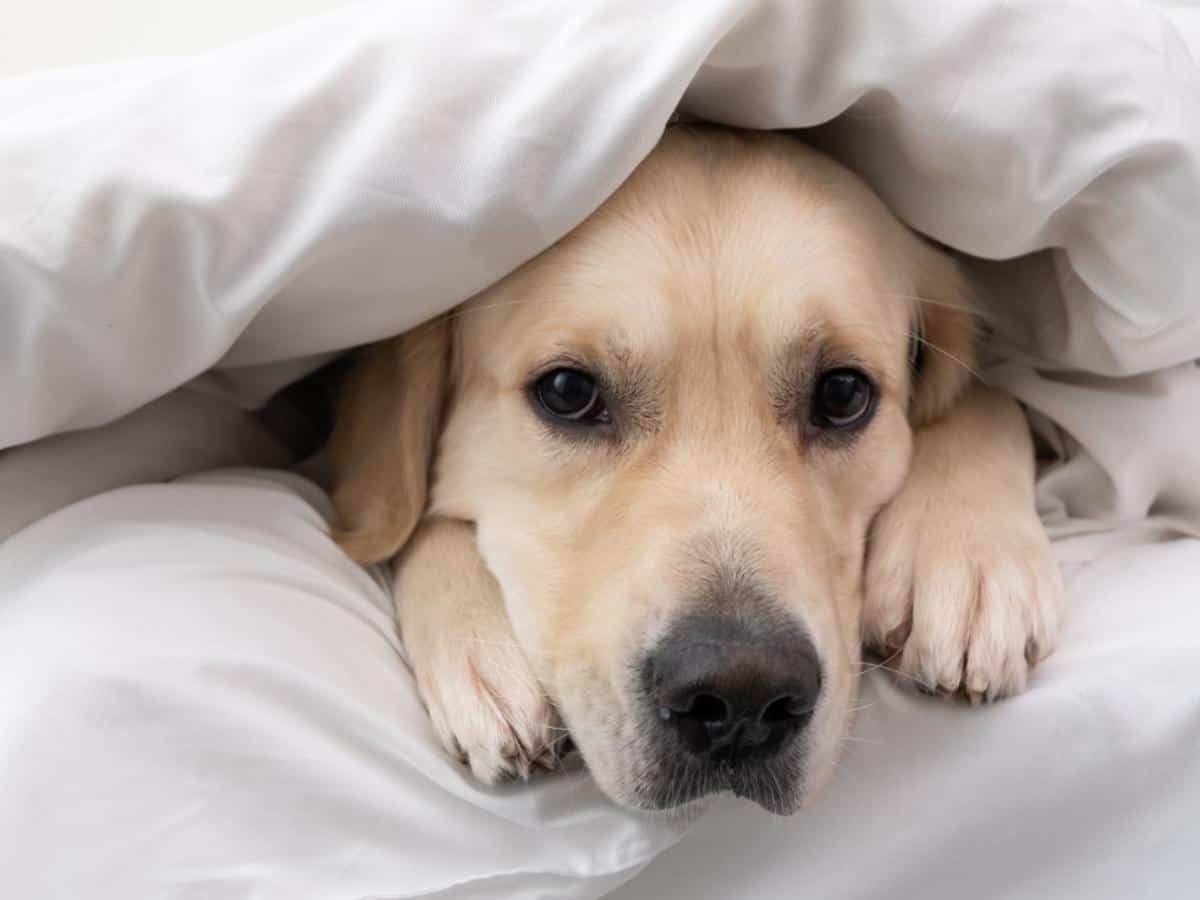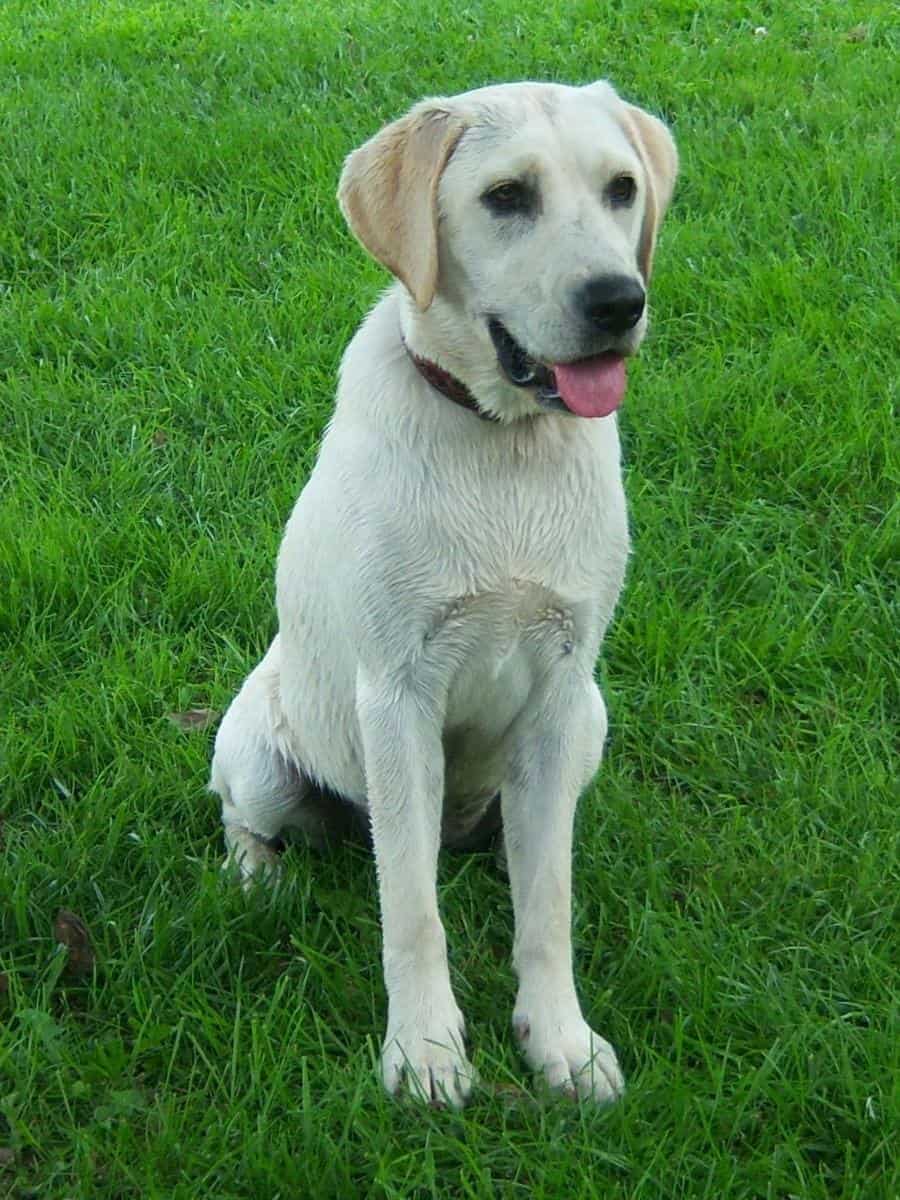If your unspayed Labrador is exhibiting signs like increased urination, a swollen and reddened vulva, along with some blood-stained discharge, rest assured, these are typical indications that she is in heat. There’s no cause for alarm, as this is a natural part of her reproductive cycle.
While most female Labs will experience their first heat cycle between 9 and 12 months of age, it’s important to note that this can vary. Some Labs may have their first heat cycle as early as 6 months, while others may not experience it until they are 2 years old.
In this post, we’ll guide you through the signs, stages, and care tips to ensure you and your furry friend navigate this phase with ease and confidence.
Whether you’re a first-time Lab parent or looking to refresh your knowledge, join us as we explore the ins and outs of a Labrador’s first heat cycle.

Labrador Retriever Heat Cycle
A Labrador’s heat cycle is when a series of hormonal changes occur. The time of first heat marks the onset of fertility, and it’s repeated every 6 months for the rest of your dog’s life.
While some age-related variations will occur during your dog’s lifetime, a Labrador Retriever’s heat cycle typically happens in four stages.
Proestrus Stage
The proestrus stage in a Labrador heat cycle is the initial period of the cycle and lasts around 4-20 days. The following signs distinguish this period:
- Swollen vulva and teats.
- Frequent urination.
- Bleeding – may be more noticeable in some dogs.
- Attracting males – but not necessarily ready to mate.
- A darkened lower abdomen.
- Covering her vulva by tucking in the tail to keep males away.
- “Mood changes” whereby your Lab may become anxious or quiet.
Some dogs may self-groom as a way of cleaning themselves, making it difficult for you to notice any bleeding. During this time, it’s critical to keep a sharp eye out for any changes that might be happening.
Estrus Stage
Estrus is the main stage in the Labrador reproduction cycle. It’s the heat period or “season” and the fertile phase of the cycle when ovulation occurs. At this point, your bitch is ready to mate.
Estrus lasts between 4 and 15 days and is characterized by the following:
- Change in the color of the discharge. This is now a pinkish/brownish liquid and not the blood-stained discharge of the proestrus stage.
- A “flagged” tail, raised and no longer hiding the vulva. This is a direct sign your Lab is getting ready to mate.
- Seeking out male dogs. If your bitch has become more active and aggressive in seeking out male dogs, this could be a sign they are in the Estrus phase.
Diestrus Stage
The diestrus phase in a Labrador’s heat cycle is marked by rest time. If your dog hasn’t conceived during the estrus period, her body will rest in preparation for her next heat season.
Diestrus in Labrador Retrievers lasts around 60 days. Although your dog may still carry the scent of the heat period, her fertile window has now closed.
Anestrus Stage
The last phase of a Labrador’s heat cycle is the anestrus stage, which lasts around 90 days. This is when your Labrador prepares for her next cycle, which will restart once more with the proestrus stage.
If you’re planning to spay your Labrador, the anestrus period is considered the most opportune time to do so. My dog was spayed in this stage of her first heat cycle.

When Do Labradors Go Into Heat?
Labradors go into heat when they’re around 6 months old. This is when they reach sexual maturity (puberty). However, it’s typical for some larger dogs to go into heat later than 6 months. Therefore, most Labrador Retrievers go into heat around 9-12 months.
Labs may also go into heat later; some dogs will even go into heat at 18 or 24 months. These variations are all within the norm, depending on your dog.
If your dog goes into heat, it doesn’t automatically imply she’s ready for breeding.
In fact, experienced Lab breeders know it’s far better to wait until the second heat, preferably the third. This gives them time to come fully into the cycle before breeding.
Waiting for the second or third heat ensures a more healthy pregnancy, as your dog’s eggs are not fully mature for reproduction at the first heat.
It also allows your dog’s body to be fully developed for gestation by this time.
How Long Does a Labrador’s First Heat Last?
Labrador’s first heat typically lasts between 2 to 4 weeks, but the duration can vary depending on the individual dog.
During this time, your Lab will experience changes in behavior and physical appearance, and it’s important to provide her with extra care and attention.
After the first heat, your Lab will go into heat once or twice a year, with each cycle lasting an average of 3 weeks. It’s crucial to understand your Lab’s heat cycle to ensure her health and well-being.
A Labrador’s first heat corresponds to the estrus stage of the heat cycle. During these days, your Lab is fertile and can get pregnant if she mates.
Throughout estrus, blood flow will reduce and then stop, and the discharge may change to a straw color.
Note, however, that a female Labrador can get pregnant if she mates before the estrus period. This is because canine spermatozoa are motile in the female’s genital tract and can potentially survive for around 11 days.
During this time, female Labradors will attract and accept males. Your dog may begin to urinate more regularly and mark spots inside and outside your home with pheromones to signal that she is ready to mate.
Given a chance, your dog will likely approach an intact male with her hindquarters first, and her tail flagged to the side.

Signs of Heat in Labradors
I often get asked how to tell when a dog is in season.
You’ll know when your Labrador is in heat by observing her for specific physical and behavioral signs, including:
- A swollen vulva and enlarged teats.
- A change in the color of discharge (pinkish instead of blood-stained).
- Frequent urination.
- Marking behavior.
- A tail flagging to the side.
- A loss of appetite.
Additionally, your dog can become more hostile against other female dogs and show heightened interest in male dogs.
Frequent licking of the genitals, urine marking, and agitation are indications of readiness to mate. Contrary to popular belief, a dog that sprays is not just a boy thing!
During this time, if you have an intact Labrador and don’t intend to breed her, you should keep your dog on a leash during walks, as she will be actively seeking a sexual partner.
How To Care for Your Labrador In Heat
Caring for your Labrador in season requires extra love and attention. Your Lab will change physically and emotionally over the season, so you must give her extra attention.
Here are 7 things you should do to care for a Labrador in heat:
- Keep your Lab busy to distract her from the uneasiness of the hormonal changes during the heat period. Playing games, offering treat-filled toys, or taking short walks can help keep your dog calm and happy. Oh, and don’t forget lots of cuddles!
- Keep your Lab away from male dogs if you don’t intend to breed her. This entails keeping her on a leash during walks, not leaving her unattended in the backyard, and keeping her separated from other male dogs you have at home. It’s an instinctual behavior for your girl to seek out a male, so ensure you check your yard for any escape routes.
- Keep your Lab from carpeted areas of the home, bedding, and couches during the bleeding part of the heat cycle. Alternatively, use dog diapers to prevent blood staining on your dog’s bedding and the flooring. Check out the Simple Solution Disposable Dog Diapers from Amazon. These have a superior fit due to the stretchable fabric that fits perfectly around your dog. If your doggo is trying to lick her vulva while in a diaper, then consider temporarily removing it to allow her to self-groom.
- Let your dog rest if she is not keen on exercising. It would be better to ease your dog’s exercise routine during the proestrus and estrus phases of the heat cycle, as she may feel a bit under the weather and have low energy.
- Ensure your Lab gets all the advised nutrients in her meal during the heat. If your Lab prefers a different meal, consider giving it to her to boost her appetite. You can add toppings to her food, such as chicken, fish, unsalted broth, or natural yogurt. Make sure she drinks lots of water and allow her extra potty breaks.
- Keep the environment calm and free of loud noise. Your dog is sensitive to any stress during this period, so you’ll want to keep her calm and relaxed.
- If your Lab shows extreme discomfort or signs of pain in the swollen vulva, use heating pads to provide some relief. I like the RIOGOO Pet Heating Pad as it has an auto power-off function for extra safety, is waterproof, and is machine washable. However, consult your vet if the uneasiness or pain doesn’t seem typical.
Note: Clicking the above link(s) will take you to Amazon or an online store where we have an affiliate relationship. If you make a purchase, we may earn a commission at no additional cost to you.
During heat, your Labrador could exhibit particular characteristics and needs. Be alert and ask your veterinarian about unusual symptoms you cannot handle.

How Often Do Labradors Go Into Heat?
Labradors enter heat every six months after their first heat cycle, so twice yearly. This is typical of medium and large dog breeds.
However, smaller breeds may go into heat 3-4 times a year, and giant breeds only once yearly.
Although there’s an approximate 6-month interval between heat cycles in Labrador Retrievers, you must remember that dogs will not go into heat like clockwork as they’re all different.
For example, this study on the canine cycle season reported 215.1 days (7.07 months) interestrus intervals in Labradors, 208.2 days (6.84 months) in German Shepherds, and 208.5 days (6.85 months) in Belgian Malinois dogs.
As mentioned, this may change depending on your dog and her body clock. How often your Labrador goes into heat may vary and is also contingent upon the following factors:
Age
After a Labrador’s first heat cycle, subsequent heat cycles may be somewhat irregular initially but will become more consistent in time.
To find out whether your dog’s irregular cycles are normal or whether there are underlying issues, you might wish to consult your veterinarian.
Instead, older Labradors will have slowed cycles with fewer heat seasons. However, despite the shorter estrus seasons, your dog will still experience estrus throughout her life and be able to become pregnant.
Conception
Canine gestation delays menstrual cycles and fertility seasons, just as humans do. Similarly, the interestrus interval, or the period between estrus seasons, is prolonged in Labradors and other dogs after whelping.
A study on the effects of whelping reported that Labrador Retrievers had a regular 6-month estrus interval under normal circumstances, but the interval was prolonged by 52 days in Labradors who went into gestation.
Seasons
Though seasonality is generally considered a non-factor in estrus frequency in Labradors and other dogs, it is not an impossibility.
This study in which Labradors raised in the tropics constituted 26% of the population (14/53) found fewer estrus incidences in summer and consequently fewer occurrences of fertility and conception.
The investigation concluded that summer-related environmental factors reduced oestrus incidence and fertility in the bitches.
FAQs
Do Labradors Go Through Menopause?
Labradors do not go through menopause. Once your Lab’s first heat occurs, your dog will have heat cycles throughout her life. Nonetheless, the estrus phase of their heat cycle will become less regular and last for fewer days as your dog ages.
If your dog misses an estrus, consult your vet to exclude any triggering medical conditions.
Must My Labrador Have a First Heat Before Being Spayed?
Your Labrador does not need to have her first heat to be spayed. However, it’s vital to know that sex hormones are a core factor in your dog’s development and health.
In fact, some studies on the ideal age of neutering have shown that spaying your Labrador before maturity (6 months) can predispose your dog to joint disorders like hip and elbow dysplasia, urinary incontinence, and cancers.
Is a White Discharge Normal During a Lab Heat Season?
A white discharge during a Labrador’s estrus is abnormal and could indicate an infection in your dog’s womb, such as pyometra. The most noticeable symptom of pyometra is a discharge of pus from the vulva in a bitch that has recently been in heat.
Have your Lab checked by a vet if you notice any discharges different from blood staining during proestrus and a pinkish or brownish discharge during estrus.





